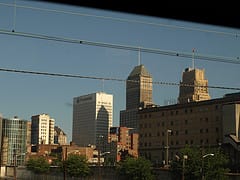Ask almost any leader of a growing urban charter school about their biggest worries, and real estate is likely to be at the top of the list. City-dwelling young parents want schools that are convenient to their homes and—increasingly—public transit. Government has (appropriately) high expectations of school buildings but provides little to no money for charter school facilities in most jurisdictions. Educators and school leaders want all of the above to provide a fantastic experience for their students—without breaking the bank. This is not something the real estate market can provide in most cities.
 Cities like Newark, New Jersey are experimenting with creative uses of space to improve education options. Photo by William F. Yurasko. |
To make the problem even more difficult, city centers are redeveloping, with entire neighborhoods gentrifying, building mixed-use housing and innovative commercial spaces. Young professionals who a generation ago might have fled for the ‘burbs as they settled into careers and started having children are now staying. This has resulted in vibrant, revitalized neighborhoods—but the pressure continues to build on large urban school districts to provide high-quality seats to meet the needs created by this cultural shift.
Increased density and the creative reuse of space can help ease the space crunch. Public charter schools have led the way on the latter front, motivated more by their scanty facilities budgets than by far-sighted views on urban planning. District schools have followed in a few cities (though redevelopments from school to commercial space is more common).
Charters in a few places are now taking this trend further. An office building in Wilmington, DE, is being converted to house several charter schools on nine floors. In Newark, a developer is building a mixed-use community centered on three public charter schools, providing classrooms as well as housing for teachers near NJIT and the New Jersey Performing Arts Center. Projects like these can bring commerce, housing, and schooling together in a way that is incredibly attractive to young urban families.
Merely being creative is not enough in many cities, however. Real estate is still very expensive, due in part to bad development policies that artificially limit the density of American cities. A new book by Slate blogger Matthew Yglesias (with the colorful title The Rent Is Too Damn High) argues that deregulation would lead to increases in the number of housing units available in attractive neighborhoods, reducing rents and making them naturally more diverse and livable—at least for people who enjoy city life.
It's easy to see how denser neighborhoods combined with creative development of mixed-use spaces could improve K-12 education.
Yglesias only touches on schooling briefly, but it's easy to see how denser neighborhoods combined with creative development of mixed-use spaces like Newark's Teachers Village could improve K-12 education. Increasing the economic diversity of schools is good for the educational outcomes of poor kids. Higher density also means more kinds of schools can open in a given neighborhood, each serving their own market: arts-intensive schools, STEM-focused schools, schools with values-based programs, and so forth.
Charter leaders would no doubt agree with Yglesias that the rent is "too damn high." In the neighborhoods that are urban renewal's success stories—vibrant, economically diverse—the opportunities to also improve primary and secondary education are significant. School leaders need help from policymakers here to improve the availability of affordable space for teaching and learning, and to plug schools into revitalized neighborhoods.
